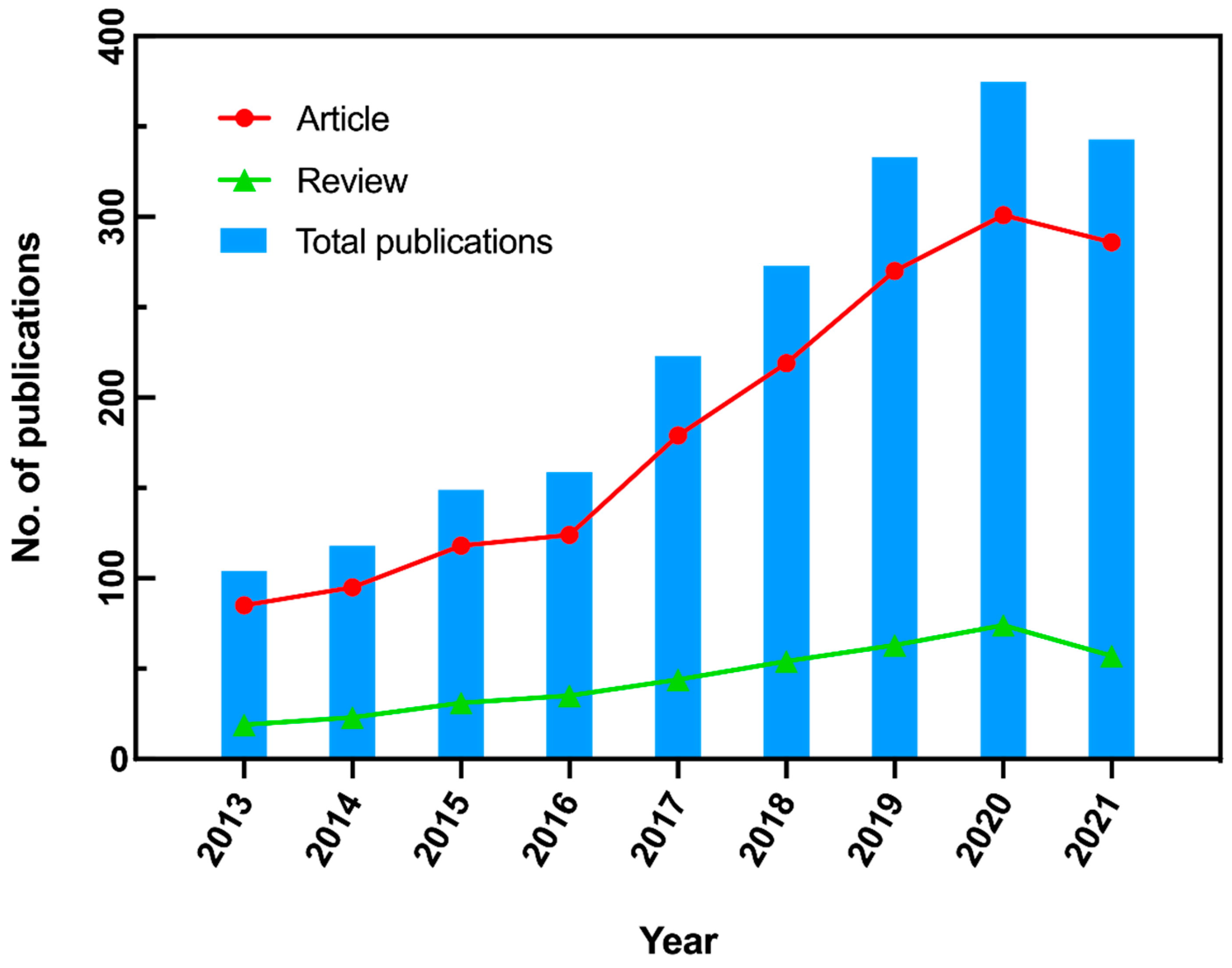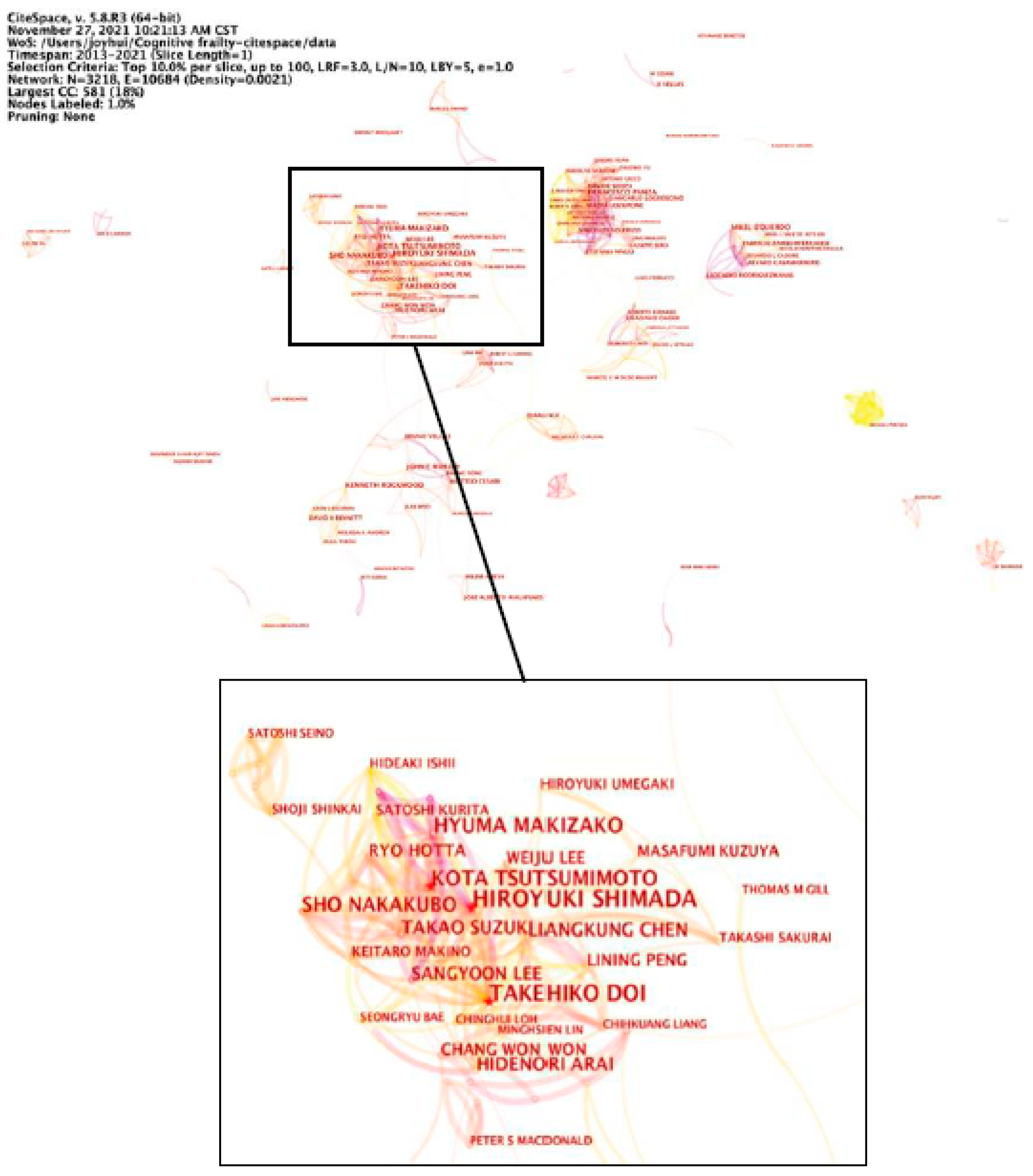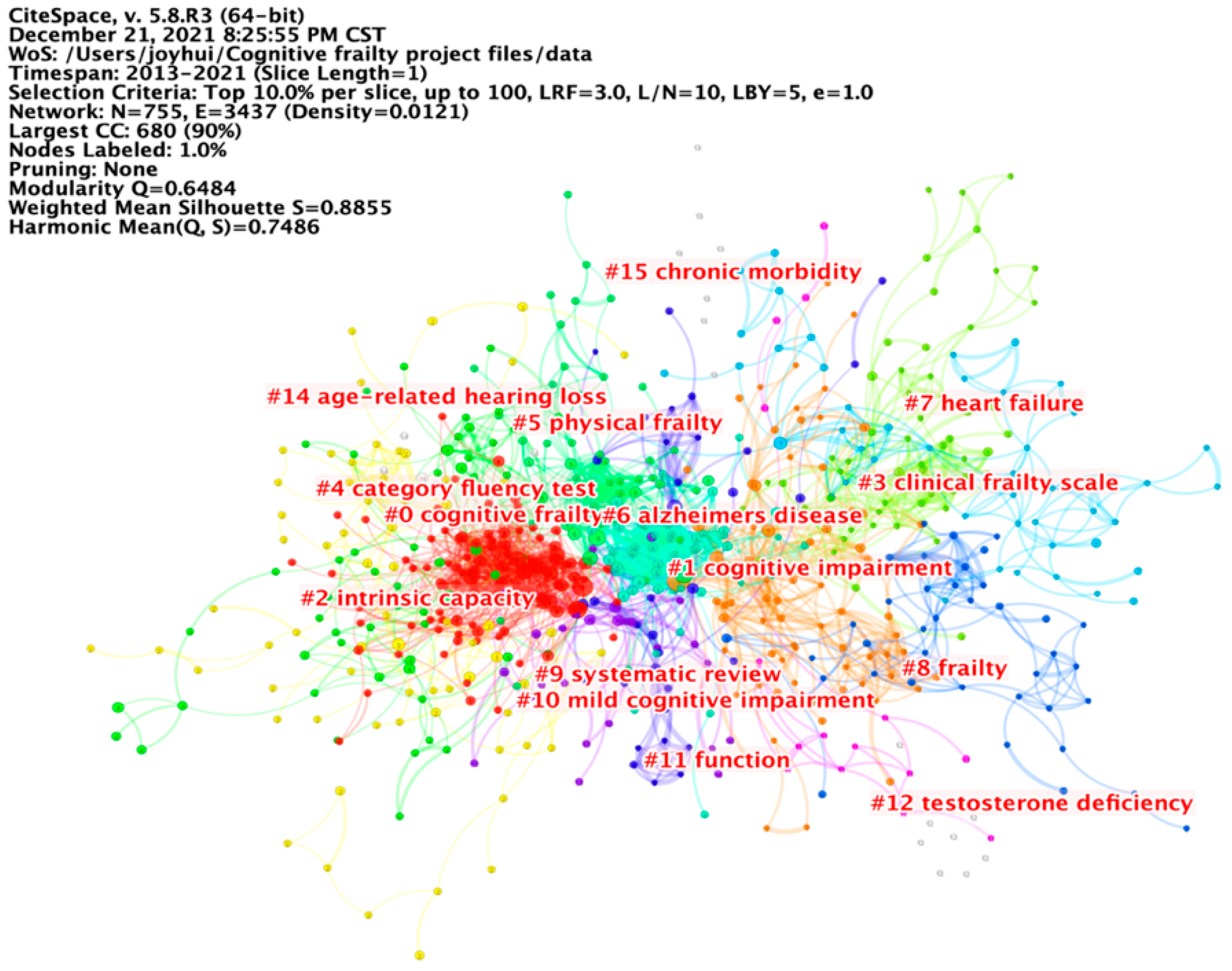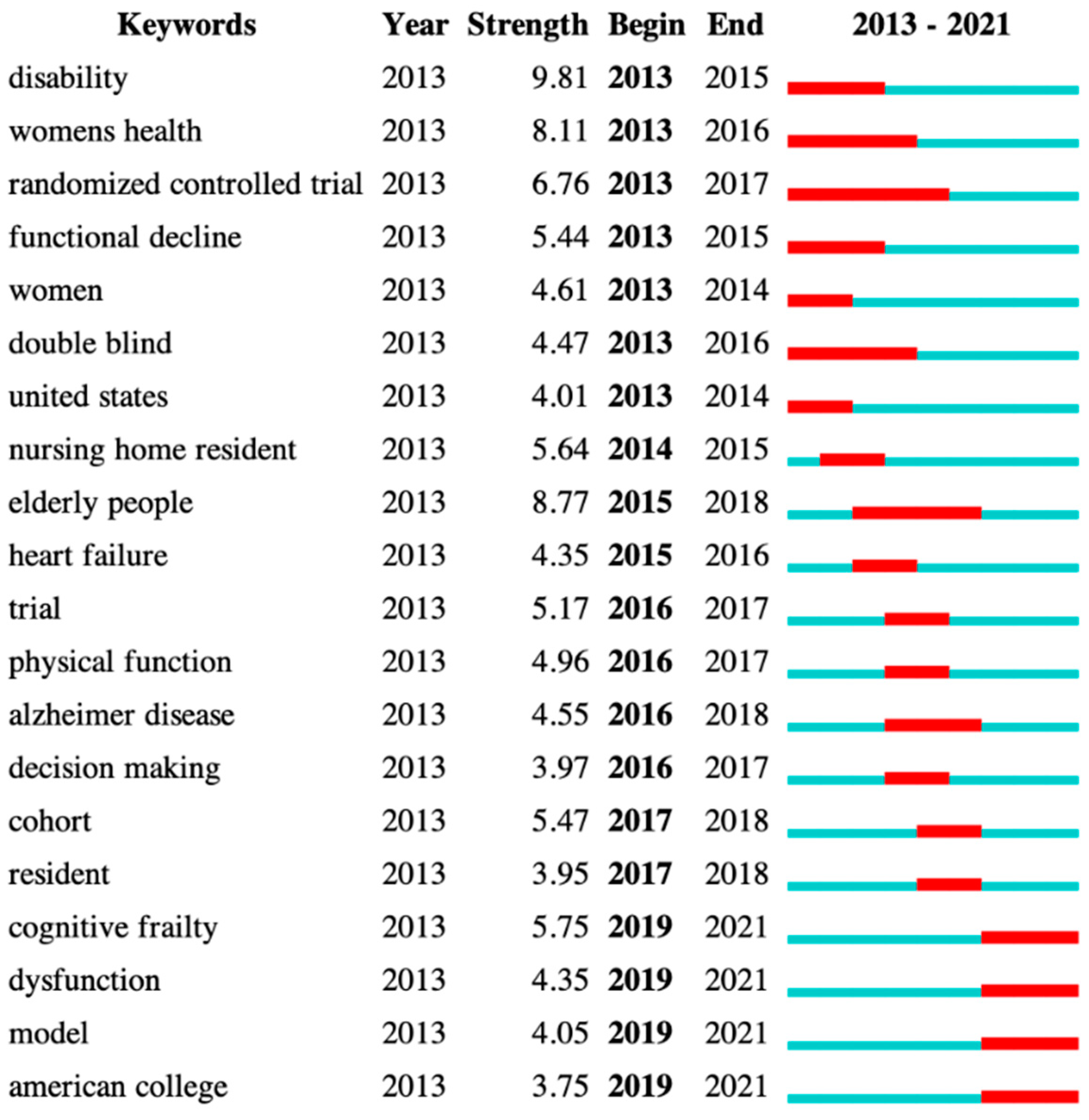Global Research on Cognitive Frailty: A Bibliometric and Visual Analysis of Papers Published during 2013–2021
Abstract
:1. Introduction
2. Methods
2.1. Data Source and Search Strategy
2.2. Inclusion and Exclusion Criteria
2.3. Data Analysis and Visualization
3. Results
3.1. Publication Years and Journals
3.2. Collaboration Analysis
3.2.1. Country Collaboration Analysis
3.2.2. Institution Collaboration Analysis
3.2.3. Author Collaboration Analysis
3.2.4. Document Co-Citation Analysis
3.2.5. Keyword Co-Occurrence Analysis
4. Discussion
5. Conclusions
Author Contributions
Funding
Institutional Review Board Statement
Informed Consent Statement
Data Availability Statement
Conflicts of Interest
References
- Morley, J.E.; Vellas, B.; van Kan, G.A.; Anker, S.D.; Bauer, J.M.; Bernabei, R.; Cesari, M.; Chumlea, W.; Doehner, W.; Evans, J.; et al. Frailty Consensus: A Call to Action. J. Am. Med Dir. Assoc. 2013, 14, 392–397. [Google Scholar] [CrossRef] [Green Version]
- Robertson, D.A.; Savva, G.M.; Kenny, R.A. Frailty and cognitive impairment—A review of the evidence and causal mechanisms. Ageing Res. Rev. 2013, 12, 840–851. [Google Scholar] [CrossRef]
- Grande, G.; Haaksma, M.L.; Rizzuto, D.; Melis, R.J.F.; Marengoni, A.; Onder, G.; Welmer, A.-K.; Fratiglioni, L.; Vetrano, D.L. Co-occurrence of cognitive impairment and physical frailty, and incidence of dementia: Systematic review and meta-analysis. Neurosci. Biobehav. Rev. 2019, 107, 96–103. [Google Scholar] [CrossRef] [PubMed]
- Boyle, P.A.; Buchman, A.S.; Wilson, R.S.; Leurgans, S.E.; Bennett, D.A. Physical Frailty Is Associated with Incident Mild Cognitive Impairment in Community-Based Older Persons. J. Am. Geriatr. Soc. 2010, 58, 248–255. [Google Scholar] [CrossRef] [PubMed]
- Ma, L.; Chan, P. Understanding the Physiological Links between Physical Frailty and Cognitive Decline. Aging Dis. 2020, 11, 405–418. [Google Scholar] [CrossRef] [PubMed] [Green Version]
- Kelaiditi, E.; Cesari, M.; Canevelli, M.; Van Kan, G.A.; Ousset, P.J.; Gillette-Guyonnet, S.; Ritz, P.; Duveau, F.; Soto, M.E.; Provencher, V.; et al. Cognitive frailty: Rational and definition from an (I.A.N.A./I.A.G.G.) International Consensus Group. J. Nutr. Health Aging 2013, 17, 726–734. [Google Scholar] [CrossRef]
- Cano, A. Cognitive frailty, a new target for healthy ageing. Maturitas 2015, 82, 139–140. [Google Scholar] [CrossRef]
- Sargent, L.; Brown, R. Assessing the current state of cognitive frailty: Measurement properties. J. Nutr. Health Aging 2017, 21, 152–160. [Google Scholar] [CrossRef]
- Qiu, Y.; Li, G.; Wang, X.; Zheng, L.; Wang, C.; Wang, C.; Chen, L. Prevalence of cognitive frailty among community-dwelling older adults: A systematic review and meta-analysis. Int. J. Nurs. Stud. 2021, 125, 104112. [Google Scholar] [CrossRef]
- Vatanabe, I.P.; Pedroso, R.V.; Teles, R.H.G.; Ribeiro, J.C.; Manzine, P.R.; Pott-Junior, H.; Cominetti, M.R. A systematic review and meta-analysis on cognitive frailty in community-dwelling older adults: Risk and associated factors. Aging Ment. Health 2021, 26, 464–476. [Google Scholar] [CrossRef]
- Xie, B.; Ma, C.; Chen, Y.; Wang, J. Prevalence and risk factors of the co-occurrence of physical frailty and cognitive impairment in Chinese community-dwelling older adults. Health Soc. Care Community 2021, 29, 294–303. [Google Scholar] [CrossRef] [PubMed]
- Bu, Z.; Huang, A.; Xue, M.; Li, Q.; Bai, Y.; Xu, G. Cognitive frailty as a predictor of adverse outcomes among older adults: A systematic review and meta-analysis. Brain Behav. 2021, 11, e01926. [Google Scholar] [CrossRef] [PubMed]
- Zheng, L.; Li, G.; Gao, D.; Wang, S.; Meng, X.; Wang, C.; Yuan, H.; Chen, L. Cognitive frailty as a predictor of dementia among older adults: A systematic review and meta-analysis. Arch. Gerontol. Geriatr. 2019, 87, 103997. [Google Scholar] [CrossRef] [PubMed]
- Ma, Y.; Li, X.; Pan, Y.; Zhao, R.; Wang, X.; Jiang, X.; Li, S. Cognitive frailty and falls in Chinese elderly people: A population-based longitudinal study. Eur. J. Neurol. 2021, 28, 381–388. [Google Scholar] [CrossRef]
- Zhang, X.-M.; Yuan, L.; Quo, N.; Bo, H.-X.; Jiao, J.; Wu, X.; Xu, T. Cognitive Frailty and Falls in a National Cohort of Older Chinese Inpatients. J. Nutr. Health Aging 2021, 25, 993–998. [Google Scholar] [CrossRef]
- Rivan, N.F.M.; Singh, D.K.A.; Shahar, S.; Wen, G.J.; Rajab, N.F.; Din, N.C.; Mahadzir, H.; Kamaruddin, M.Z.A. Cognitive frailty is a robust predictor of falls, injuries, and disability among community-dwelling older adults. BMC Geriatr. 2021, 21, 593. [Google Scholar] [CrossRef]
- Chen, C. CiteSpace II: Detecting and visualizing emerging trends and transient patterns in scientific literature. J. Am. Soc. Inf. Sci. Technol. 2006, 57, 359–377. [Google Scholar] [CrossRef] [Green Version]
- Facal, D.; Maseda, A.; Pereiro, A.X.; Gandoy-Crego, M.; Lorenzo-López, L.; Yanguas, J.; Millán-Calenti, J.C. Cognitive frailty: A conceptual systematic review and an operational proposal for future research. Maturitas 2019, 121, 48–56. [Google Scholar] [CrossRef]
- Sugimoto, T.; Sakurai, T.; Ono, R.; Kimura, A.; Saji, N.; Niida, S.; Toba, K.; Chen, L.-K.; Arai, H. Epidemiological and clinical significance of cognitive frailty: A mini review. Ageing Res. Rev. 2018, 44, 1–7. [Google Scholar] [CrossRef]
- Donthu, N.; Kumar, S.; Mukherjee, D.; Pandey, N.; Lim, W.M. How to conduct a bibliometric analysis: An overview and guidelines. J. Bus. Res. 2021, 133, 285–296. [Google Scholar] [CrossRef]
- Chen, Y.; Chen, C.M.; Liu, Z.Y.; Hu, Z.G.; Wang, X.W. The methodology function of Cite Space mapping knowledge domains. Stud. Sci. Sci. 2015, 33, 242–253. [Google Scholar] [CrossRef]
- Clegg, A.; Young, J.; Iliffe, S.; Rikkert, M.O.; Rockwood, K. Frailty in elderly people. Lancet 2013, 381, 752–762. [Google Scholar] [CrossRef] [Green Version]
- Feng, L.; Nyunt, M.S.Z.; Gao, Q.; Feng, L.; Yap, K.B.; Ng, T.-P. Cognitive Frailty and Adverse Health Outcomes: Findings from the Singapore Longitudinal Ageing Studies (SLAS). J. Am. Med. Dir. Assoc. 2017, 18, 252–258. [Google Scholar] [CrossRef] [PubMed] [Green Version]
- Shimada, H.; Makizako, H.; Doi, T.; Yoshida, D.; Tsutsumimoto, K.; Anan, Y.; Uemura, K.; Ito, T.; Lee, S.; Park, H.; et al. Combined Prevalence of Frailty and Mild Cognitive Impairment in a Population of Elderly Japanese People. J. Am. Med. Dir. Assoc. 2013, 14, 518–524. [Google Scholar] [CrossRef]
- Ruan, Q.; Yu, Z.; Chen, M.; Bao, Z.; Li, J.; He, W. Cognitive frailty, a novel target for the prevention of elderly dependency. Ageing Res. Rev. 2015, 20, 1–10. [Google Scholar] [CrossRef]
- Shimada, H.; Makizako, H.; Lee, S.; Doi, T.; Tsutsumimoto, K.; Harada, K.; Hotta, R.; Bae, S.; Nakakubo, S.; Suzuki, T. Impact of cognitive frailty on daily activities in older persons. J. Nutr. Health Aging 2016, 20, 729–735. [Google Scholar] [CrossRef]
- Solfrizzi, V.; Scafato, E.; Seripa, D.; Lozupone, M.; Imbimbo, B.; D’Amato, A.; Tortelli, R.; Schilardi, A.; Galluzzo, L.; Gandin, C.; et al. Reversible Cognitive Frailty, Dementia, and All-Cause Mortality. The Italian Longitudinal Study on Aging. J. Am. Med. Dir. Assoc. 2017, 18, 89.e1–89.e8. [Google Scholar] [CrossRef]
- Feng, L.; Nyunt, M.S.Z.; Gao, Q.; Feng, L.; Lee, T.S.; Tsoi, T.; Chong, M.S.; Lim, W.S.; Collinson, S.; Yap, P.; et al. Physical Frailty, Cognitive Impairment, and the Risk of Neurocognitive Disorder in the Singapore Longitudinal Ageing Studies. J. Gerontol. Ser. A 2017, 72, 369–375. [Google Scholar] [CrossRef] [Green Version]
- Lee, J.S.W.; Auyeung, T.-W.; Leung, J.; Kwok, T.; Leung, P.-C.; Woo, J. Physical frailty in older adults is associated with metabolic and atherosclerotic risk factors and cognitive impairment independent of muscle mass. J. Nutr. Health Aging 2011, 15, 857–862. [Google Scholar] [CrossRef]
- ÃVila-Funes, J.A.; Amieva, H.; Barberger-Gateau, P.; Le Goff, M.; Raoux, N.; Ritchie, K.; Carriã¨re, I.; Tavernier, B.; Tzourio, C.; Robledo, L.M.G.; et al. Cognitive Impairment Improves the Predictive Validity of the Phenotype of Frailty for Adverse Health Outcomes: The Three-City Study. J. Am. Geriatr. Soc. 2009, 57, 453–461. [Google Scholar] [CrossRef]
- Panza, F.; Lozupone, M.; Solfrizzi, V.; Sardone, R.; Dibello, V.; Di Lena, L.; D’Urso, F.; Stallone, R.; Petruzzi, M.; Giannelli, G.; et al. Different Cognitive Frailty Models and Health- and Cognitive-related Outcomes in Older Age: From Epidemiology to Prevention. J. Alzheimer’s Dis. 2018, 62, 993–1012. [Google Scholar] [CrossRef] [PubMed] [Green Version]
- Collard, R.M.; Boter, H.; Schoevers, R.A.; Voshaar, R.O. Prevalence of Frailty in Community-Dwelling Older Persons: A Systematic Review. J. Am. Geriatr. Soc. 2012, 60, 1487–1492. [Google Scholar] [CrossRef]
- Fu, L.; Sun, Z.; He, L.; Liu, F.; Jing, X. Global Long-Term Care Research: A Scientometric Review. Int. J. Environ. Res. Public Health 2019, 16, 2077. [Google Scholar] [CrossRef] [PubMed] [Green Version]
- Fu, J.; Jiang, Z.; Hong, Y.; Liu, S.; Kong, D.; Zhong, Z.; Luo, Y. Global scientific research on social participation of older people from 2000 to 2019: A bibliometric analysis. Int. J. Older People Nurs. 2021, 16, e12349. [Google Scholar] [CrossRef] [PubMed]
- Aaldriks, A.A.; van der Geest, L.G.; Giltay, E.J.; le Cessie, S.; Portielje, J.E.; Tanis, B.C.; Nortier, J.W.; Maartense, E. Frailty and malnutrition predictive of mortality risk in older patients with advanced colorectal cancer receiving chemotherapy. J. Geriatr. Oncol. 2013, 4, 218–226. [Google Scholar] [CrossRef] [PubMed]
- Culley, D.J.; Flaherty, D.; Fahey, M.C.; Rudolph, J.L.; Javedan, H.; Huang, C.-C.; Wright, J.; Bader, A.M.; Hyman, B.T.; Blacker, D.; et al. Poor Performance on a Preoperative Cognitive Screening Test Predicts Postoperative Complications in Older Orthopedic Surgical Patients. Anesthesiology 2017, 127, 765–774. [Google Scholar] [CrossRef]
- Mistry, P.K.; Gaunay, G.S.; Hoenig, D.M. Prediction of surgical complications in the elderly: Can we improve outcomes? Asian J. Urol. 2016, 4, 44–49. [Google Scholar] [CrossRef] [Green Version]
- Aili, S.R.; De Silva, R.; Wilhelm, K.; Jha, S.R.; Fritis-Lamora, R.; Montgomery, E.; Pierce, R.; Lam, F.; Brennan, X.; Gorrie, N.; et al. Validation of Cognitive Impairment in Combination with Physical Frailty as a Predictor of Mortality in Patients with Advanced Heart Failure Referred for Heart Transplantation. Transplantation 2021, 106, 200–209. [Google Scholar] [CrossRef]
- Hao, Q.; Dong, B.; Yang, M.; Dong, B.; Wei, Y. Frailty and Cognitive Impairment in Predicting Mortality Among Oldest-Old People. Front. Aging Neurosci. 2018, 10, 295. [Google Scholar] [CrossRef] [Green Version]
- Yuan, Y.; Lapane, K.L.; Tjia, J.; Baek, J.; Liu, S.-H.; Ulbricht, C.M. Physical Frailty and Cognitive Impairment in Older Adults in United States Nursing Homes. Dement. Geriatr. Cogn. Disord. 2021, 50, 60–67. [Google Scholar] [CrossRef]
- Buvat, J.; Maggi, M.; Guay, A.; Torres, L.O. Testosterone Deficiency in Men: Systematic Review and Standard Operating Procedures for Diagnosis and Treatment. J. Sex. Med. 2013, 10, 245–284. [Google Scholar] [CrossRef] [PubMed]
- Yoon, D.H.; Lee, J.-Y.; Song, W. Effects of Resistance Exercise Training on Cognitive Function and Physical Performance in Cognitive Frailty: A Randomized Controlled Trial. J. Nutr. Health Aging 2018, 22, 944–951. [Google Scholar] [CrossRef] [PubMed]
- Kwan, R.Y.; Lee, D.; Lee, P.H.; Tse, M.; Cheung, D.S.; Thiamwong, L.; Choi, K.-S. Effects of an mHealth Brisk Walking Intervention on Increasing Physical Activity in Older People with Cognitive Frailty: Pilot Randomized Controlled Trial. JMIR mHealth uHealth 2020, 8, e16596. [Google Scholar] [CrossRef] [PubMed]
- Xia, R.; Wan, M.; Lin, H.; Qiu, P.; Ye, Y.; He, J.; Yin, L.; Tao, J.; Chen, L.; Zheng, G. Effects of a traditional Chinese mind–body exercise, Baduanjin, on the physical and cognitive functions in the community of older adults with cognitive frailty: Study protocol for a randomised controlled trial. BMJ Open 2020, 10, e034965. [Google Scholar] [CrossRef] [PubMed] [Green Version]
- Romera-Liebana, L.; Orfila, F.; Segura, J.M.; Real, J.; Fabra, M.L.; Möller, M.; Lancho, S.; Ramirez, A.; Marti, N.; Cullell, M.; et al. Effects of a Primary Care-Based Multifactorial Intervention on Physical and Cognitive Function in Frail, Elderly Individuals: A Randomized Controlled Trial. J. Gerontol. Ser. A 2018, 73, 1668–1674. [Google Scholar] [CrossRef]
- Ponvel, P.; Shahar, S.; Singh, D.K.A.; Ludin, A.F.M.; Rajikan, R.; Rajab, N.F.H.; Ai-Vyrn, C.; Din, N.C.; Ibrahim, N.; Subramaniam, P.; et al. Multidomain Intervention for Reversal of Cognitive Frailty, Towards a Personalized Approach (AGELESS Trial): Study Design. J. Alzheimer’s Dis. 2021, 82, 673–687. [Google Scholar] [CrossRef]
- Murukesu, R.R.; Singh, D.K.A.; Shahar, S.; Subramaniam, P. A Multi-Domain Intervention Protocol for the Potential Reversal of Cognitive Frailty: “WE-RISE” Randomized Controlled Trial. Front. Public Health 2020, 8, 471. [Google Scholar] [CrossRef]
- Solfrizzi, V.; Scafato, E.; Lozupone, M.; Seripa, D.; Giannini, M.; Sardone, R.; Bonfiglio, C.; Abbrescia, D.I.; Galluzzo, L.; Gandin, C.; et al. Additive Role of a Potentially Reversible Cognitive Frailty Model and Inflammatory State on the Risk of Disability: The Italian Longitudinal Study on Aging. Am. J. Geriatr. Psychiatry 2017, 25, 1236–1248. [Google Scholar] [CrossRef]
- World Health Organization. World Report on Ageing and Health; World Health Organization: Geneva, Switzerland, 2015. [Google Scholar]
- Beard, J.R.; Si, Y.; Liu, Z.; Chenoweth, L.; Hanewald, K. Intrinsic Capacity: Validation of a New WHO Concept for Healthy Aging in a Longitudinal Chinese Study. J. Gerontol. Ser. A 2022, 77, 94–100. [Google Scholar] [CrossRef]
- Belloni, G.; Cesari, M. Frailty and Intrinsic Capacity: Two Distinct but Related Constructs. Front. Med. 2019, 6, 133. [Google Scholar] [CrossRef]







| Journal | No. of Publications (%) | IF a | JCR ® Category |
|---|---|---|---|
| 75 (3.61) | 3.921 | Geriatrics & Gerontology (Q2) Gerontology (Q1) |
| 62 (2.99) | 4.669 | Geriatrics & Gerontology (Q2) |
| 61 (2.94) | 4.075 | Geriatrics & Gerontology (Q2) Nutrition & Dietetics (Q2) |
| 52 (2.50) | 2.730 | Geriatrics & Gerontology (Q3) Gerontology (Q2) |
| 46 (2.22) | 3.250 | Geriatrics & Gerontology (Q3) |
| 44 (2.12) | 5.562 | Geriatrics & Gerontology (Q1) Gerontology (Q1) |
| 41 (1.97) | 6.053 | Geriatrics & Gerontology (Q3) Gerontology (Q1) |
| 33 (1.59) | 3.638 | Geriatrics & Gerontology (Q3) |
| 33 (1.59) | 4.458 | Geriatrics & Gerontology (Q2) |
| 33 (1.59) | 4.472 | Neurosciences (Q2) |
| No. | Count | Centrality | Strength | Reference | Year | Begin | End |
|---|---|---|---|---|---|---|---|
| 1 | 126 | 0.12 | 26.58 | Clegg, et al. [22] | 2013 | 2015 | 2018 |
| 2 | 109 | 0.01 | 27.16 | Kelaiditi, et al. [6] | 2013 | 2016 | 2018 |
| 3 | 92 | 0.02 | 18.96 | Robertson, et al. [2] | 2013 | 2015 | 2018 |
| 4 | 83 | 0.00 | 18.00 | Morley, et al. [1] | 2013 | 2015 | 2018 |
| 5 | 73 | 0.06 | 7.54 | Feng, et al. [23] | 2017 | 2018 | 2021 |
| 6 | 59 | 0.03 | 15.23 | Shimada, et al. [24] | 2013 | 2015 | 2018 |
| 7 | 58 | 0.01 | 10.26 | Ruan, et al. [25] | 2015 | 2018 | 2021 |
| 8 | 56 | 0.06 | 5.87 | Shimada, et al. [26] | 2016 | 2018 | 2019 |
| 9 | 55 | 0.01 | 4.86 | Solfrizzi, et al. [27] | 2017 | 2019 | 2021 |
| 10 | 54 | 0.02 | 6.30 | Feng, et al. [28] | 2017 | 2018 | 2021 |
| 11 | 13 | 0.11 | 4.77 | Lee, et al. [29] | 2011 | 2013 | 2016 |
| 12 | 36 | 0.00 | 16.15 | Boyle, et al. [4] | 2010 | 2013 | 2015 |
| 13 | 26 | 0.00 | 14.33 | Ávila-Funes, et al. [30] | 2009 | 2013 | 2014 |
| 14 | 48 | 0.01 | 13.43 | Panza, et al. [31] | 2018 | 2019 | 2021 |
| 15 | 35 | 0.03 | 12.27 | Collard, et al. [32] | 2012 | 2015 | 2017 |
Publisher’s Note: MDPI stays neutral with regard to jurisdictional claims in published maps and institutional affiliations. |
© 2022 by the authors. Licensee MDPI, Basel, Switzerland. This article is an open access article distributed under the terms and conditions of the Creative Commons Attribution (CC BY) license (https://creativecommons.org/licenses/by/4.0/).
Share and Cite
Hui, Z.; Wang, X.; Zhou, Y.; Li, Y.; Ren, X.; Wang, M. Global Research on Cognitive Frailty: A Bibliometric and Visual Analysis of Papers Published during 2013–2021. Int. J. Environ. Res. Public Health 2022, 19, 8170. https://doi.org/10.3390/ijerph19138170
Hui Z, Wang X, Zhou Y, Li Y, Ren X, Wang M. Global Research on Cognitive Frailty: A Bibliometric and Visual Analysis of Papers Published during 2013–2021. International Journal of Environmental Research and Public Health. 2022; 19(13):8170. https://doi.org/10.3390/ijerph19138170
Chicago/Turabian StyleHui, Zhaozhao, Xiaoqin Wang, Ying Zhou, Yajing Li, Xiaohan Ren, and Mingxu Wang. 2022. "Global Research on Cognitive Frailty: A Bibliometric and Visual Analysis of Papers Published during 2013–2021" International Journal of Environmental Research and Public Health 19, no. 13: 8170. https://doi.org/10.3390/ijerph19138170
APA StyleHui, Z., Wang, X., Zhou, Y., Li, Y., Ren, X., & Wang, M. (2022). Global Research on Cognitive Frailty: A Bibliometric and Visual Analysis of Papers Published during 2013–2021. International Journal of Environmental Research and Public Health, 19(13), 8170. https://doi.org/10.3390/ijerph19138170





